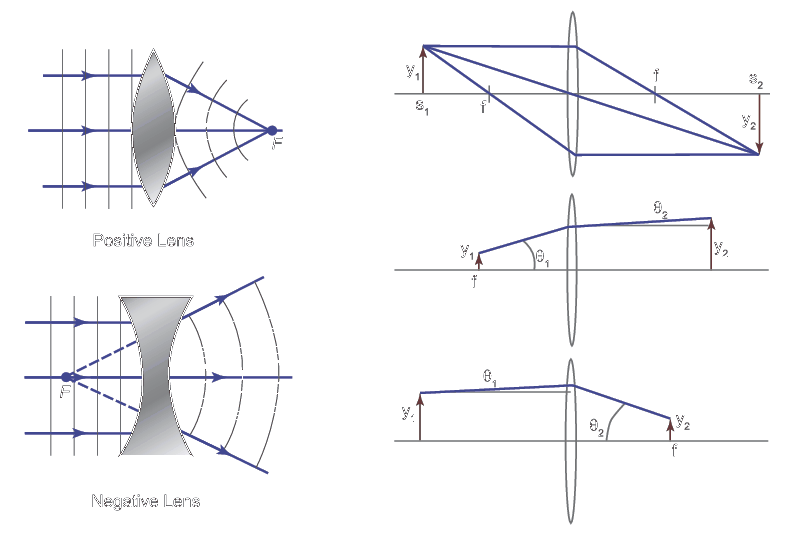Optical Lens Physics
Optical Lens Physics
Optical Lens Physics
Lenses are the optical components that form the basic building blocks of many common optical devices, including cameras, binoculars, microscopes, and telescopes. Lenses are essentially light-controlling elements and so are exploited for light gathering and image formation. Curved mirrors (see Optical Mirror Physics) and lenses can accomplish many of same things in terms of light collection and image formation. However, lenses tend to be superior in terms of image formation because they are transparent, which allows light to be transmitted directly along the axis to the detector whereas mirrors require an off-axis geometry. Mirrors are typically preferred in terms of light collection as they can be made significantly more lightweight than lenses and therefore can achieve larger diameters and light collecting ability. This section discusses the mechanism of refraction that underlies the operation of a lens, issues that affect its performance, and the different lens types.
In addition to light reflecting off a planar interface between two media, it can also be transmitted and then refracted in the second medium (see Figure 1). Refraction refers to the change in the angle of the incident light when it enters the second medium. Since the speed of light in a medium is inversely proportional to its index of refraction, it will either slow down or speed up when it enters a different medium, resulting in the light changing its direction. Figure 1 shows an example where the index of the second medium (n2) is greater than the first (n1), which results in a bending of the light toward the normal to the interface. This phenomenon of refraction is described by Snell's law:
Refraction

where θi and θr are the angles of incidence and refraction, respectively (see Figure 94). Snell's law enables determination of the refracted ray direction provided the incident ray direction and refractive indices are known. This basic formula governs how lenses control the transmission of light for collection and imaging purposes.

Figure 1. Illustration of Snell's law of refraction at an interface between media of refractive indexes n1 and n2.
A lens is typically made up of a transparent dielectric material like fused silica or optical glass with the front and back surfaces having a spherical curvature. Since the surfaces are curved, each ray of light that comes in parallel to the optical axis (as shown in Figure 2) has a different value of θi with respect to the surface normal. Each ray then refracts according to Snell's law. For a positive lens, this causes the light to converge toward its focal point on the right side of the lens while light will diverge from the focal point located on the left side of a negative lens. The ramifications of these operations are that lenses can be used for image formation as well as collection and collimation of light (see Figure 2). There are several important aspects to optical imaging with lenses, including the relationship between object and image distances and the resulting magnification as well as the quality of the resulting images.

Figure 2. Illustration of how a lens affects incoming parallel light rays (left). Applications of lenses (right) include creating a magnified image of an object (top), collimating light from a point source (middle), focusing a collimated light source (bottom).
Optical Aberrations and Types of Lenses

Figure 3. Effects of spherical aberration (left) and chromatic aberration (right) on collimation when a point source is at the focal point.
While spherical lenses do induce aberrations, choosing the proper lens shape can help minimize optical aberrations (see Figure 4). For instance, plano-convex lenses, where only one side is curved, are the best choice for focusing parallel rays of light to a single point. Bi-convex lenses (both sides have curvature that may not be equal to one another) are the best choice for imaging when the object and image are at similar distances from the lens. When a single spherical lens may be unsuitable due to spherical aberration, aspheric lenses may be used. These lenses have surfaces with tailored curvatures that help minimize the impact of aberrations but are typically expensive due to the complexities associated with fabrication. Alternatively, multiple spherical lenses can be used where one lens can cancel the aberration caused by another, as shown in Figure 4. In addition to correcting for monochromatic aberrations, an achromatic doublet can be used to minimize chromatic aberrations by choosing the dispersion of the materials in the two lenses to produce a focal length that is independent of wavelength. Microscope objectives are multi-element lens systems that can significantly reduce the impacts of aberrations but are more expensive due to the complexity of the design. All the aforementioned lenses are rotationally symmetric, that is, light focuses the same regardless of which transverse axis it passes through. On the other hand, cylindrical lenses focus or expand light in one axis only and so are ideal for modifying an asymmetric beam like the output of a laser diode into a symmetric one. There are many features to take into consideration when choosing a lens, including focal length, lens shape, F/#, lens material, transmission properties, wavefront distortion, scattered light, types of coating, and cost.

Figure 4. Using single and multiple lens systems to minimize optical aberrations for a specific imaging application.
Related Topics
Optical Components
- Optical Mirror Physics
- Optical Lens Physics
- Diffraction Grating Physics
- Optical Coatings
- Optical Filters
Optical Systems